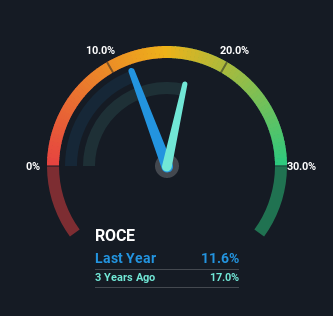Stock Analysis
- Hong Kong
- /
- Infrastructure
- /
- SEHK:357
The Returns At Hainan Meilan International Airport (HKG:357) Aren't Growing

What trends should we look for it we want to identify stocks that can multiply in value over the long term? Ideally, a business will show two trends; firstly a growing return on capital employed (ROCE) and secondly, an increasing amount of capital employed. Put simply, these types of businesses are compounding machines, meaning they are continually reinvesting their earnings at ever-higher rates of return. However, after briefly looking over the numbers, we don't think Hainan Meilan International Airport (HKG:357) has the makings of a multi-bagger going forward, but let's have a look at why that may be.
What is Return On Capital Employed (ROCE)?
Just to clarify if you're unsure, ROCE is a metric for evaluating how much pre-tax income (in percentage terms) a company earns on the capital invested in its business. The formula for this calculation on Hainan Meilan International Airport is:
Return on Capital Employed = Earnings Before Interest and Tax (EBIT) ÷ (Total Assets - Current Liabilities)
0.12 = CN¥562m ÷ (CN¥11b - CN¥6.3b) (Based on the trailing twelve months to December 2021).
Thus, Hainan Meilan International Airport has an ROCE of 12%. On its own, that's a standard return, however it's much better than the 6.0% generated by the Infrastructure industry.
Check out our latest analysis for Hainan Meilan International Airport

In the above chart we have measured Hainan Meilan International Airport's prior ROCE against its prior performance, but the future is arguably more important. If you'd like, you can check out the forecasts from the analysts covering Hainan Meilan International Airport here for free.
What Can We Tell From Hainan Meilan International Airport's ROCE Trend?
Over the past five years, Hainan Meilan International Airport's ROCE has remained relatively flat while the business is using 25% less capital than before. When a company effectively decreases its assets base, it's not usually a sign to be optimistic on that company. So if this trend continues, don't be surprised if the business is smaller in a few years time.
Another point to note, we noticed the company has increased current liabilities over the last five years. This is intriguing because if current liabilities hadn't increased to 56% of total assets, this reported ROCE would probably be less than12% because total capital employed would be higher.The 12% ROCE could be even lower if current liabilities weren't 56% of total assets, because the the formula would show a larger base of total capital employed. So with current liabilities at such high levels, this effectively means the likes of suppliers or short-term creditors are funding a meaningful part of the business, which in some instances can bring some risks.
What We Can Learn From Hainan Meilan International Airport's ROCE
Overall, we're not ecstatic to see Hainan Meilan International Airport reducing the amount of capital it employs in the business. Investors must think there's better things to come because the stock has knocked it out of the park, delivering a 204% gain to shareholders who have held over the last five years. Ultimately, if the underlying trends persist, we wouldn't hold our breath on it being a multi-bagger going forward.
If you'd like to know about the risks facing Hainan Meilan International Airport, we've discovered 1 warning sign that you should be aware of.
While Hainan Meilan International Airport may not currently earn the highest returns, we've compiled a list of companies that currently earn more than 25% return on equity. Check out this free list here.
Valuation is complex, but we're helping make it simple.
Find out whether Hainan Meilan International Airport is potentially over or undervalued by checking out our comprehensive analysis, which includes fair value estimates, risks and warnings, dividends, insider transactions and financial health.
View the Free AnalysisHave feedback on this article? Concerned about the content? Get in touch with us directly. Alternatively, email editorial-team (at) simplywallst.com.
This article by Simply Wall St is general in nature. We provide commentary based on historical data and analyst forecasts only using an unbiased methodology and our articles are not intended to be financial advice. It does not constitute a recommendation to buy or sell any stock, and does not take account of your objectives, or your financial situation. We aim to bring you long-term focused analysis driven by fundamental data. Note that our analysis may not factor in the latest price-sensitive company announcements or qualitative material. Simply Wall St has no position in any stocks mentioned.
About SEHK:357
Hainan Meilan International Airport
Engages in the aeronautical and non-aeronautical businesses at the Haikou Meilan Airport in Haikou, the People's Republic of China.
Reasonable growth potential with worrying balance sheet.

